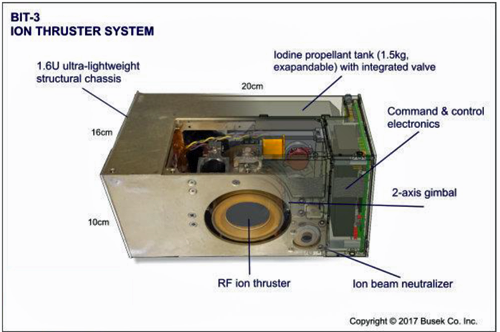
Space propulsion firm Busek Co. Inc. has confirmed their ‘BIT-3’ ion thruster system has completed two separate Critical Design Reviews (CDR) for upcoming cubesat spaceflight programs.
CDRs are major milestones prior to manufacturing flight hardware, the initial set of BIT-3 flight systems being scheduled for delivery in Q1 of 2018. The iodine fueled solar electric propulsion systems are the first of their kind, enabling an entirely new range of small spacecraft missions.

Two public missions relying upon the BIT-3 for high delta-v propulsion include Morehead State University’s Lunar IceCube and Arizona State University’s LunaH-Map. The NASA-funded, University-lead science missions will each place a 14 kilogram (30.9 lbs.) CubeSat into lunar polar orbit after deployment from NASA’s Space Launch System EM-1 mission. The miniature solar electric propulsion system incorporates several patented and patent-pending features, including the use of solid iodine propellant versus traditional high-pressure Xenon gas.
The BIT-3 iodine thruster system is capable of generating more than two kilometers per second (4,474 MPH) of delta-v for 6U cubesats, opening the possibility for small spacecraft to complete a range of missions previously reserved for large, high-cost satellites. Each compact BIT-3 system includes highly integrated control electronics, iodine tank and feed system, thruster, and gimbal for primary propulsion and attitude control.
While an increasing number of miniature electric propulsion systems are advertised in today’s marketplace, the BIT-3 system uses flight-proven gridded ion engine technology in a new miniaturized form. The BIT-3’s performance has been accurately measured and published in peer-reviewed journals, and is one of the most mature miniature solar electric propulsion systems available for order today.
Professor Ben Malphrus, Principal Investigator of Morehead State University’s Lunar IceCube mission, stated that this mission wouldn’t be possible without the BIT-3, and the university is proud to have Busek as a partner — this is a game-changing technology for the entire cubesat community.
Prof. Craig Hardgrove, Arizona State University’s Principal Investigator for LunaH-Map, noted that the BIT-3 is critical technology that will allow small spacecraft and cubesats to acquire high quality scientific results on interplanetary missions throughout the solar system. It truly enables the science of the LunaH-Map mission, mapping water-ice at the lunar south pole with a miniature neutron spectrometer.


